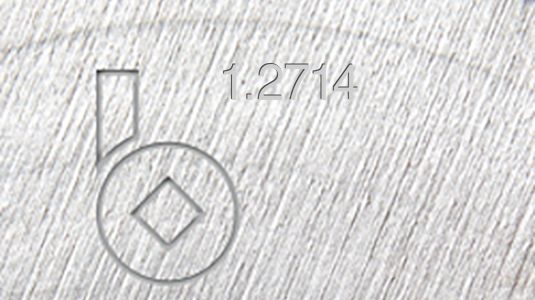Material 1.2714
Hot work tool steel
pecial alloys for toolmaking: Hot work tool steel | Properties of material 1.2714
Toolmakers manufacture instruments for the production of objects from a wide variety of materials. In order to succeed in giving these materials a shape, the tool must be harder than the starting material to be machined at the respective working temperature. The working temperature is a decisive criterion. It influences the hardness of the tool steels. For the above reason, we distinguish cold work steel and hot work steel.
Characteristics of hot work tool steel & special properties of material 1.2714
The hardness values of hot work steels do not reach those of cold work tool steels. This is due to the fact that the metals to be processed are equally softer in the hot state. In line with this, the carbon content of hot work tool steel is lower and in the majority of cases ranges between 0.25 and 0.55%. Material 1.2714 has a carbon content of 0.55%.
Hot work tool steel is mainly quenched and tempered to around 40-50 HRC. Important alloying elements for this type of tool steel are chromium, molybdenum, vanadium and tungsten. They make a hot work tool steel more temper-resistant.
Material 1.2714 is a tough die steel with high tempering resistance and through hardening. In the round steel sector, it is generally supplied annealed or quenched and tempered to an installation hardness of 370-410 HB.
In the square and flat steel range annealed, respectively with a hardness of 355-400 HB.
This tool steel is suitable for the manufacture of all types of forging dies, die holders, armored cutting plates and hot shear blades.
Physical properties of material 1.2714
According to the material data sheet, the coefficient of thermal expansion 10 to the power of 6 m/(m x K) as a function of temperature ranges from 12.2 (temperature range 20-100 °C) to 14.4 (temperature between 20 °C and 600 °C).
2 The thermal conductivity W/(m x K) stated in the material data sheet is as follows:
20 °C: 36,0
350 °C: 38,0
700 °C: 35,0
You can obtain this tool steel for hot work in the following delivery forms:
- Round steel
- square steel
- flat steel
Do you have any questions about the material or would you like to order? Complete our inquiry form, it`s free of charge and without obligation. We will get in touch with you in order to provide you with more information.

Standards
| HDIN / EN | US-Standard | AFNOR | UNI | JIS | request |
|---|---|---|---|---|---|
| 55NiCrMoV7 56NiCrMoV7 | AISI L6 UNS T61206 | 55NiCrMoV7KU 56NiCrMoV7KU | SKT4 | request |
Material Category: Hot work tool steel
Applications
Forging dies
hot shear blades
Pressure plates
Heat Treatment
- When soft annealing at 650-700 °C and cooling in the furnace, a maximum of 250 HB annealing hardness can be achieved.
- Hardening temperature of 830-870 °C and quenching with oil achieves a hardness value of 58 HRC after quenching.
- Hardening in the temperature range of 860-900 °C and quenching in air achieves 56 HRC after quenching.
- Tempering after quenching reveals variable hardness properties of material 1.2714 depending on the medium and temperature. The hardness decreases from 57/55 HRC (oil/air) at 100 °C to 34/32 HRC (oil/air) at a temperature of 650 °C.
Chemical Composition
| C % | Si % | Mn % | P % | S % | Cr % | Mo % | Ni % | V % |
| 0,50 - 0,60 | 0,10 - 0,40 | 0,60 - 0,90 | max 0,030 | max 0,030 | 0,80 - 1,20 | 0,35 - 0,55 | 1,50 - 1,80 | 0,05 - 0,15 |
Product Specifications
DIN EN ISO 4957
Mechanical Properties
| DIN EN ISO 4957 Werkzeugstähle. Legierte Werkzeugstähle für Warmarbeit. | ||
| geglüht | Härte (HBW) | <= 248 HBW |
| gehärtet | Härte (HRC) | ~ 59,9 HRC |
| vergütet | Härte (HBW) | ~ 380 HBW |
| angelassen bei ~ 50 ° C | Härte (HRC) | ~ 59,4 HRC |
| angelassen bei ~ 100 ° C | Härte (HRC) | ~ 58,6 HRC |
| angelassen bei ~ 150 ° C | Härte (HRC) | ~ 57,8 HRC |
| angelassen bei ~ 200 ° C | Härte (HRC) | ~ 56,6 HRC |
| angelassen bei ~ 250 ° C | Härte (HRC) | ~ 55,4 HRC |
| angelassen bei ~ 300 ° C | Härte (HRC) | ~ 53,9 HRC |
| angelassen bei ~ 350 ° C | Härte (HRC) | ~ 52,2 HRC |
| angelassen bei ~ 400 ° C | Härte (HRC) | ~ 50,5 HRC |
| angelassen bei ~ 450 ° C | Härte (HRC) | ~ 48,4 HRC |
| angelassen bei ~ 500 ° C | Härte (HRC) | ~ 46,3 HRC |
| angelassen bei ~ 550 ° C | Härte (HRC) | ~ 44 HRC |
| angelassen bei ~ 600 ° C | Härte (HRC) | ~ 41,6 HRC |
| gehärtet und angelassen | |
| Härte (HBW) | <= 268 HBW |
| Härte (HRC) | >= 42 HRC |
Material request
![[Translate to Englisch:] [Translate to Englisch:]](/fileadmin/bilder/slider/Werkstoffe/basedo_stahlrohre_werkstoffe.jpg)
![[Translate to Englisch:] [Translate to Englisch:]](/fileadmin/bilder/slider/Werkstoffe/HeaderWerkstoffe.jpg)
![[Translate to Englisch:] [Translate to Englisch:]](/fileadmin/bilder/slider/Werkstoffe/HeaderWerkstoffe2.jpg)
![[Translate to Englisch:] [Translate to Englisch:]](/fileadmin/bilder/slider/Werkstoffe/HeaderWerkstoffe4.jpg)